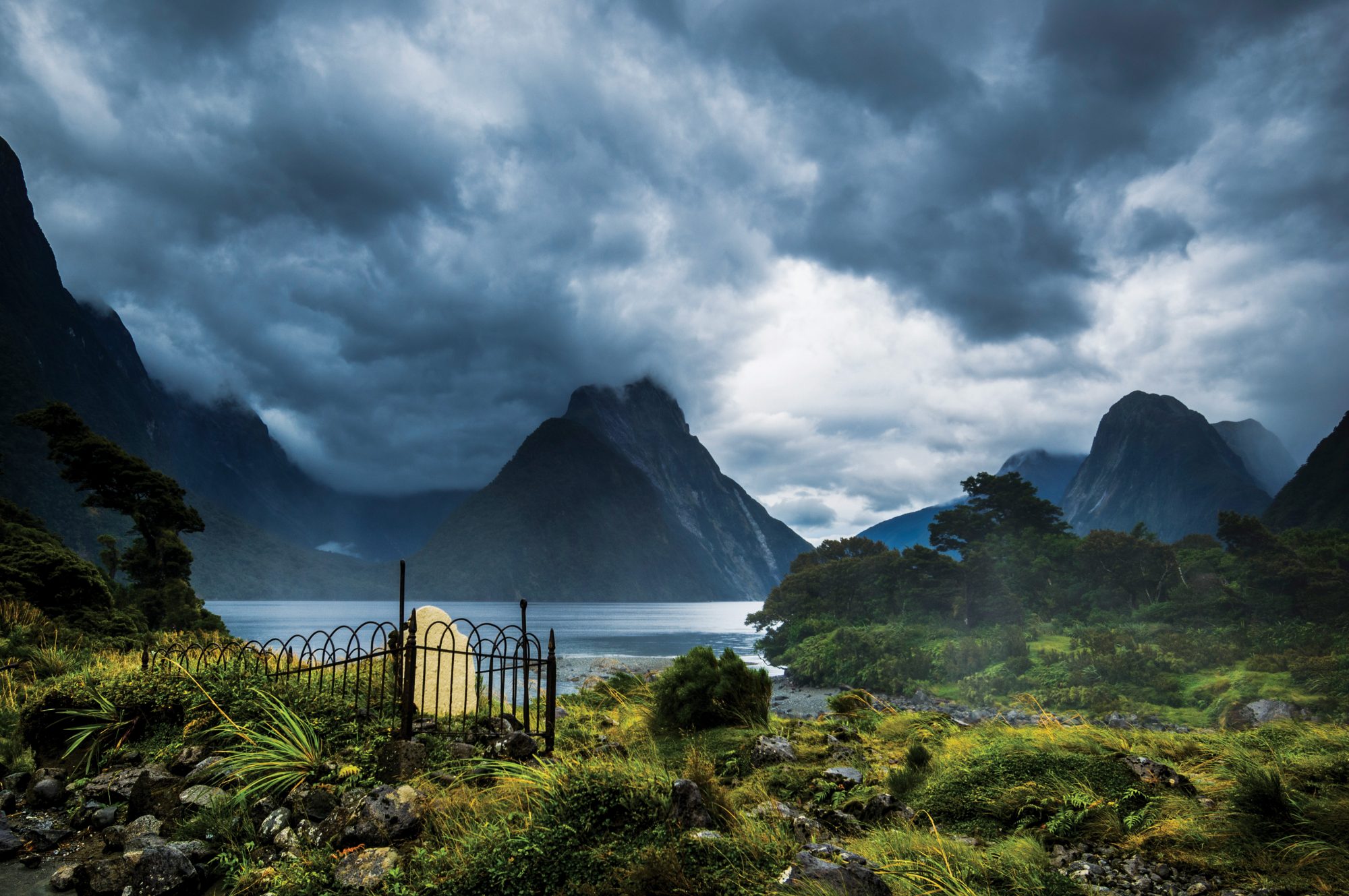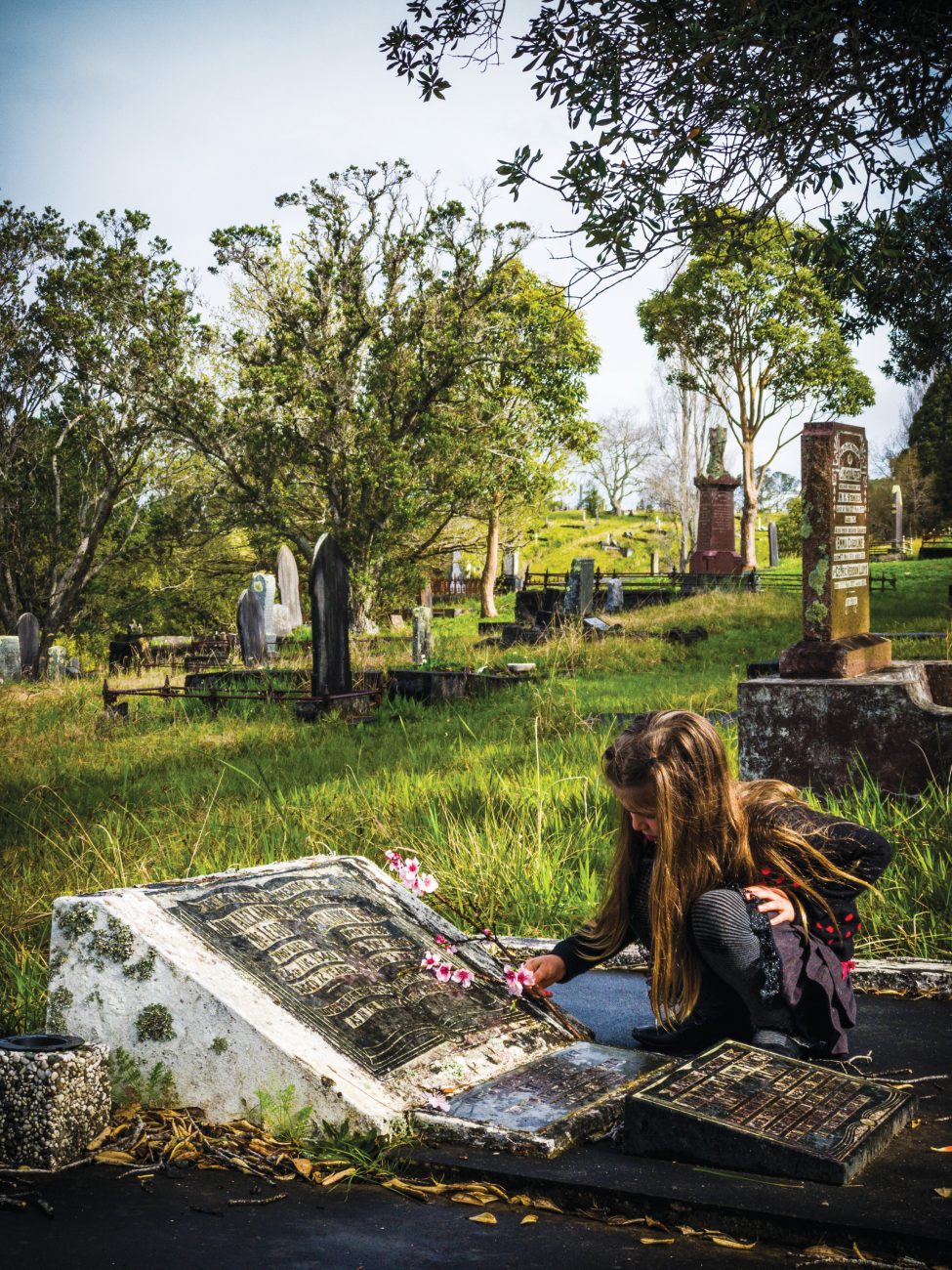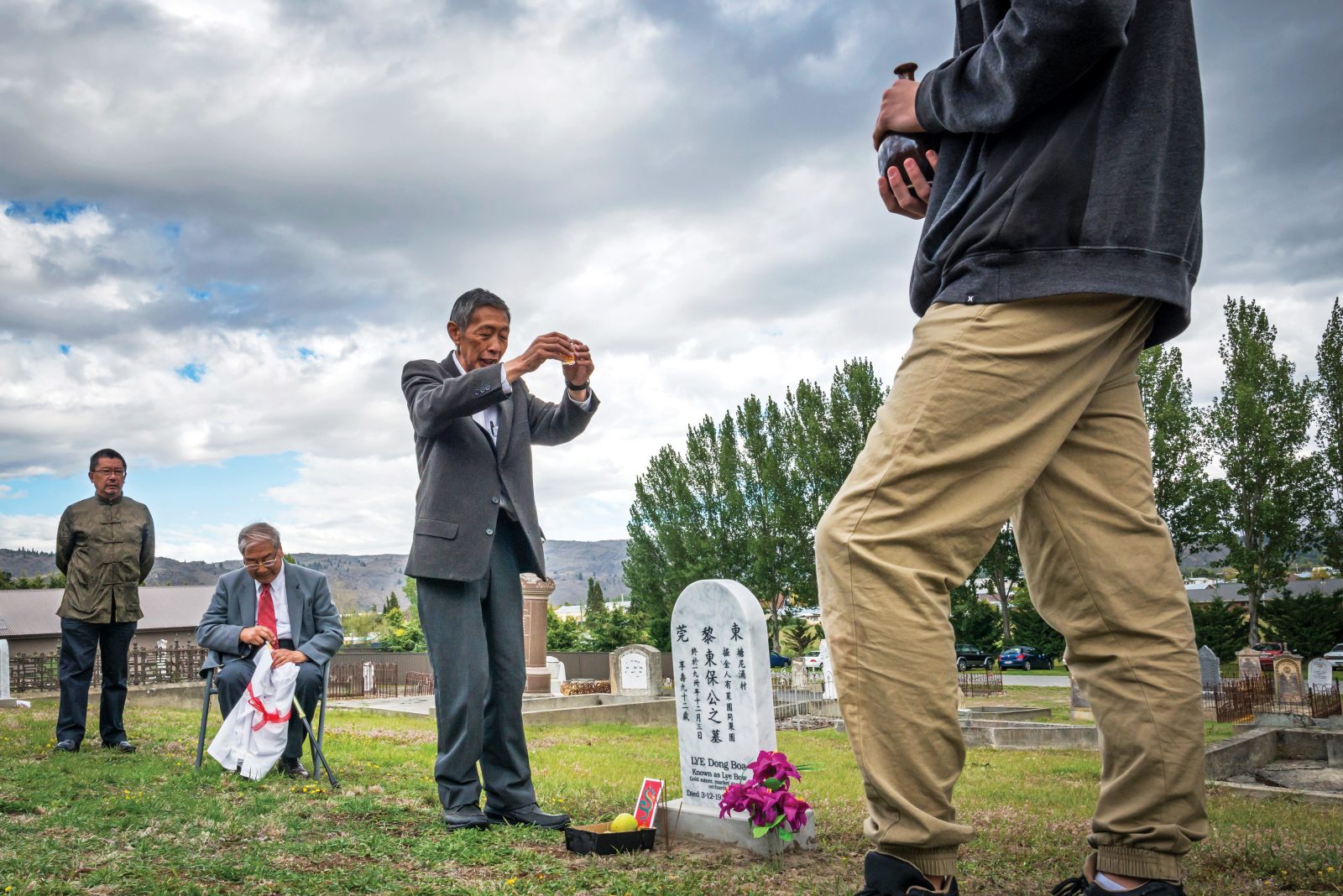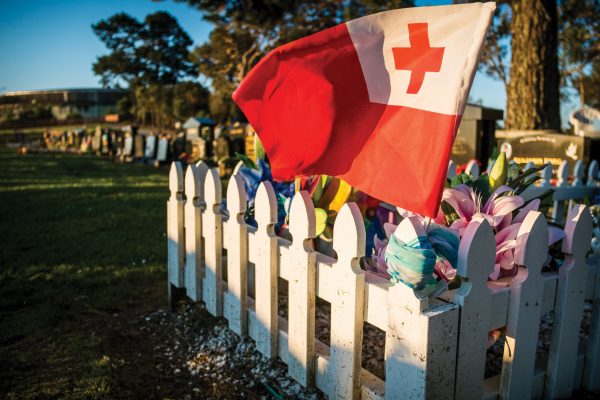
Grave matters
Death was once a constant presence. People passed away at home, and their bodies remained there until burial. Art was full of reminders of our own mortality, while churchgoers confronted the afterlife every Sunday morning. Today, death has been abstracted—it takes place in hospitals, the deceased are swiftly removed to funeral homes, and we no longer decorate our homes with reminders that, one day, our time will be up. What have we lost?
It’s the opening weekend of the duck-shooting season when I turn up at a farm in the Catlins to stay with a Southland gravedigger. As a townie, I’m unaware that this is akin to gate-crashing Christmas. But I’m enfolded into Bruce and Gaye Lamb’s southern hospitality, and the weekend turns out to be a rolling feast. By 10am on Saturday morning, the kitchen bench is heaving with slow-cookers containing freshly plucked ducks.
That afternoon, Bruce and I head down the road to Quarry Hills Cemetery. It’s one of the few in New Zealand where graves are still dug by hand. Bruce is on the cemetery committee, as was his father before him.
“We have a straightforward system,” he says. “When someone dies, the funeral director gives one of us a call and gives us the casket measurements. We meet at the cemetery and grab a couple of extra helpers. Digging takes a couple of hours. We always know who we’re digging for, so we tell stories while we dig. There’s a bit of black humour and some whisky. We chuck the young fella in to finish off the last bit—you need to be fit to get yourself out.”

The young fella is Craig Short, a 30-something farmer who lives across the road from the cemetery. He completed an apprenticeship in cabinetmaking before returning to the family farm, and he takes pride in digging a neat, rectangular hole.
“We’re careful but it’s a bit nerve-racking—at funerals we all hang back a bit hoping the casket fits when it’s lowered in,” Craig laughs. “I went to my uncle’s funeral in town a while back and I thought, ‘Gee, what a rough-looking hole’. Undertakers tell us it’s nice to see a hand-dug grave—it looks like somebody cares.”
For the members of the cemetery committee, gravedigging is an act of care.
“You want to do a good job—it’s the last thing you can do for someone,” says Bruce. “Working together to dig feels personal. It feels like part of the goodbye to that person.”
It’s a peaceful place, Quarry Hills, and I jokingly ask him how much it is to get buried here.
“It’s $50,” I’m told with a grin, “but everyone so far has been a local. We’d have to have a chat about how much to charge for an out-of-towner.”
[Chapter Break]
The cemetery committee members would be surprised to learn they’re part of an international trend—a growing movement to make death personal and to restore its place in daily life.

New Zealand has six Death Cafes, forums that are part of a global volunteer initiative where strangers meet over tea and cake for a general discussion about death—the idea being that people make friends with their own mortality. (Since the first Death Cafe’s inception in 2011, more than 7600 have been held in 65 countries.)
Around New Zealand, retirees meet at coffin clubs, an idea started by a Rotorua palliative-care nurse in 2010. People come together to build coffins in order to save money on future funeral costs, and they make friends in the process. Across the Ditch, there’s an annual Festival of Death and Dying in Sydney and Melbourne.
This idea is old news for many New Zealanders—especially those from cultures who long ago dedicated days to remembering the dead. Chinese people observe Tomb Sweeping Day in April, and in Japan there’s a whole week devoted to it in August.

While New Zealand’s death-positivity movement is still fledgling, among industry professionals there is growing understanding of the shifts in society towards more hands-on engagement with death and death care. Kristine Rose, the Nelson-based director of Choice Home Funerals, points out that the movement represents a rediscovery of old rituals, rather than being anything new.
“All through human history and up until about 1940, people died at home and remained at home, cared for by family members until their burial. Contact with death was just an ordinary part of life.”
Kristine gives families who wish to keep their deceased at home advice on practicalities such as keeping the body cool (ice packs, dry ice or a cooling blanket), washing and dressing, and being with them until the funeral and disposal. She usually recommends families keep the deceased at home for one to three days, explaining that the changes to the body are, in most cases, very gradual, and that the benefits of doing so are significant in terms of a chance to process grief. “Having time with the body of the loved one … really helps families to get used to the fact that they aren’t really there in the body any more. It’s a tactile experience that makes the death more real for them.”
Kristine’s experience of losing her sister at age 17 was a catalyst for her journey into home-based death care.
“Viewing my sister’s dead body briefly at a funeral home, and the very abrupt way she was taken for cremation, was just awful. Not having a body to grieve over really messed with my head. I kept thinking, ‘Did it really happen?’
“I just didn’t want to be in this culture where we dealt with death and dying in this detached way. I’ve always been really interested in other cultures and I became aware there were other ways of dealing with things.”
At Melbourne’s Festival of Death and Dying, Kristine worked with artist Maree Clarke to create a kopi, a clay hat worn by indigenous Australians until they felt the worst period of mourning had passed. It was a meaningful experience for Kristine, who has Aboriginal ancestry. “It’s those kinds of physical experiences that are so important for us in processing grief,” she says.
Today, one of the most rewarding aspects of her work is seeing the way death care connects families. “There’s always a lot of talking and remembering, and laughter mixed with the tears. You can go in and sit with the body at midnight if you want to, or sleep beside them or talk to them or have a good cry whenever that wave of emotion hits you. Once you’ve experienced this, it seems strange that our default is to call the professionals as soon as someone dies. Then they arrive with a gurney, and the next time you see that person you’ve loved so deeply is at the funeral home, and you have a short time to say your goodbyes, in that very formal and unfamiliar environment.”


In ‘death-positive’ style, I do a little window-shopping of caskets in Nelson. Kristine’s business offers simple cardboard coffins, which cost $260 and are “a hit with kids, who love having the chance to help decorate them”, as well as pine and plywood caskets from local makers Return to Sender, Departure Lounge and Down to Earth. I’m torn between a rough-sawn pine casket and the romantic shroud-bearer, which looks as though it’s ready to head out to sea. These would cost me $1195 and $785 respectively. While I’m not quite ready to purchase a casket to keep in the carport, my coffin-cruising reveals to me that there’s something cathartic about thinking through your own burial preferences.
[Chapter Break]
Cost aside, there are ethical implications around most disposal choices. Land’s at a premium, and cremation spews out carbon—what’s a corpse to do?
New Zealanders on the whole prefer cremation, with 70 per cent of us opting to go this way, but Māori and Pacific Islanders generally choose burial.
Sally Raudon, a social anthropologist at the University of Auckland, says cremation may be dominant in New Zealand because it suits our values.
“There’s that tendency to not want to be any bother—cremation is perceived as quick and clean. It reflects our practical way of life.”
New Zealanders usually bury or cremate a body within three to five days, which Sally says is rushed compared to many countries.
“In Sweden, the body is usually cold-stored. Several weeks can pass before it is buried.”
This is partly because there’s a strong emphasis on adhering to correct process: “You would delay the funeral until the right person is available to speak, or wait for the organist to come back from holiday. Six or even eight weeks between the death and funeral would be perfectly normal.”
Cremation seems normal to us today, but it wasn’t always so. Before the 1960s, it was considered a bit radical. New methods of body disposal—natural burial, body composting, and resomation—are likely to follow a similar pattern of slow acceptance.
Inside a resomation chamber, water mixes with potassium hydroxide, heating to 150°C and liquifying the body. When the liquid is drained away, the bones remain, as they do in cremation, and are ground. Environmentally, resomation is an improvement on cremation, because it uses a quarter of the fuel. Resomation chambers are sleek silver pods that generate nothing more menacing than a hum.


In natural burial, the body is dressed in a shroud and placed in shallower ground than a coffin to facilitate faster decomposition. A native tree or shrub is planted above the grave so that in the long term, natural burial grounds become native forests, with GPS locators rather than headstones indicating the position of the burial plots. New Zealand now has several natural burial plots within existing cemeteries, but uptake has so far been slow.
Perhaps the most radical option is recomposition, in which human remains are rapidly converted into soil using a system developed by United States architect and social entrepreneur Katrina Spade. Her non-profit, Recompose, recently completed a proof-of-concept study with Washington State University, and a state senator is sponsoring a bill to expand Washington’s end-of-life options, as only burial and cremation are legally permitted at present. Recomposition, which is cheaper than cremation, is designed for those who would like to give back to the earth—a final act of gratitude in the form of a wheelbarrow full of fine loam.
[Chapter Break]
On State Highway 3, beyond the driftwood-strewn border towns of Awakino and Mokau, I catch a glimpse of Mount Taranaki among the clouds. I take this as a good omen. I’m on my way to Parihaka to stay with a kuia whose life work is the revival of ancient death practices. It’s no light visit, and the mountain’s solid symmetry is a reassuring sight.
‘Surf Highway 45’ between New Plymouth and Opunake is alive with a wild evening light that electrifies the grass and deep-grey sky. The kids are in the back seat, and as we drive, I try to do justice to Parihaka’s stories of courage and resistance, describing the market gardens, loaves of bread, singing children, peace flags—and the 1600 soldiers. My throat constricts with the burden of the other stories I can’t tell them yet: looting, incarceration, brutal displacement. This weekend, we’ll be joining the great-grandchildren of Parihaka leader Te Whiti o Rongomai as whānau gather for a hui that takes place on the 18th day of every month—a commemoration at which Parihakatanga is discussed, debated and kept alive.
Being there is an enormous privilege. We’re turning up for dinner empty-handed, so I’m relieved when our host, Maata Wharehoka, suggests I pick up some frozen chocolate eclairs. You can’t go too far wrong with a woman who’s as interested in the particulars of pudding as in the synchronicity of life and death. I start to feel at home before we’ve even arrived.
Maata and her sister-in-law, Agnes Wharehoka, welcome us to Te Hapū o Rongo, a family home built to honour their ancestors. The next morning, we join the 18th Sabbath Day hui in another meeting house, Te Niho o te Atiawa.
By the time Maata and I settle down to chat on the front porch of her whare, Mount Taranaki is shrouded in rain. In the distance, it’s a symbolic link between the realms of the physical and the spiritual.
Maata’s first passion was for traditional Māori birth practices, in partnership with her husband, Te Ru Koriri Wharehoka, a Parihaka kaumātua.
“We believed in revitalising whatever we could that was in tikanga Māori,” she explains. “I was a registered nurse, and first it was birthing.”
When Te Ru became terminally ill, the couple’s focus shifted towards death, and the ways people prepare for it, with the help of those around them. ‘Dying’ is a passive word, says Maata, and she suggests we adopt her more-active term ‘deathing’, a counterpart for ‘birthing’. She hopes it will one day be in the dictionary.

Te Ru thought carefully about his own deathing. He requested not to be embalmed, and to stay home during his death, and afterwards. In this, he was assisted by Maata and their children, who had all received instructions about their role in taking care of him once his wairua had left his body.
“He died here in the back bedroom,” she says. “The first day, he stayed at home. On the second day, we took him to the marae for the local people to mourn. When my whanaunga—relative—saw him laid out at Te Niho o te Atiawa, she thought it was so real and beautiful and asked if she could bring in a film crew to document what we were doing. So his tangi was filmed, and that’s been used to help others reimagine what after-death can look like.”
[sidebar-1]
In thinking about deathing, Maata and Te Ru aimed to remove the bureaucratic formalities of a century and a half of colonisation. This wasn’t easy. Maata points out that early historians, being Pākehā men, didn’t record details, and “there’s nothing written by Māori women”. She scoured books and papers to find details of how the tūpāpaku, the body of the deceased, was cared for.
Ngāpuhi have some records, she says, but there isn’t a lot remaining. “We’re so colonised we don’t have the knowledge of the old practices.”
She discovered that tūpāpaku were wrapped in kōpaki—mats woven from harakeke—and were often arranged in a seated position, in front of the house on the marae ātea, where mourners could assemble.
“When Te Ru Koriri died and we had him laid out, one of the elders said it was 70 years since she’d seen anything like it—they could remember it from their childhood,” says Maata. “He died in 2007, so that’s about the 1940s that the practices were starting to be lost.”
Maata’s workshops on death practices, or kahu whakatere tūpāpaku, are in demand around the country, and she now conducts them with her son, Te Akau.

“What we teach is in eight parts: the weaving of mats, making a basket to transport the body, making ropes, supporting the wairua as it embarks on its journey home, caring for and managing the body without embalming, waiata, reo and karakia.”
Kahu whakatere tūpāpaku has a transformational impact on families, she says.
“What a special way to help to grieve and help to heal. Even watching others help will help people to come through with less pain. Even little children, seven- and eight-year-olds, have stayed with us to help make the ropes. They’re owning what’s happening, taking it on board. Kinaesthetic interactions are so important to Māori.
“I believe we’ve got to normalise death. The spirit of death is one that families have got to be taught. Especially families that don’t want them to pass over—you need to ask them whether they want their loved one to live with pain or to pass over. You can ask the dying person the length of time they want to stay around—they can participate in the process of their own death.”
Maata also has personal experience to draw on. In 2000, she had a serious accident and spent five weeks in a coma, coming close to death several times.
“I had three attempts at passing over,” she says. “The third time, they decided to pull the plug. My family came to visit me. I was aware of a lot although I was unconscious—I could laugh with people when they made a joke and protest when they turned me and it hurt.
“I heard the doctor say that it was time to turn off the switch. When I returned from the dead, I picked on him and told him off. They turned the switch off and I continued to breathe. I made a decision to continue to live because of my children.
“By that time, my spirit had travelled wide and far, down to the South Island to the urupā of my ancestors, to Tauranga where my parents and aunt are buried. I came back here searching for a place to die. No one wanted to have me. I came to this marae and spoke to a living woman and she told me to return. Life on this Earth since the accident has been a lot of work. I have taken on a lot.”


Maata has decided to “move back in time” in order to embrace as much of pre-colonial ways as she can. She uses a fire to heat her water—something which is a challenge when she has her six grandchildren over—and has built a composting toilet as well as an “earth bed”, fashioned out of soil, sand and clay.
“It’s not practical,” she admits, “but it’s the mere thought that I’m closer to the earth.”
The kahu whakatere tūpāpaku programme has also led Maata towards the environmental movement—thanks to words spoken by noted academic Rangimarie Turuki Rose Pere on a visit to Parihaka in 2003.
“Rose said to me, ‘You have to be part of healing Papatūānuku,” says Maata. “At the time, it sounded ridiculous. I’d just buried a pile of rubbish in my yard and I thought she was telling me off, as if she had seen me in the spirit world making a big mess of Papatūānuku. So, I started recycling and that kind of thing, and now with the work we’re doing, Rose’s prediction makes sense. This whole process is environmentally safe.”
[Chapter Break]
In the wake of all this death awareness, I make my own belated pilgrimage to the grave of my maternal grandparents, who are interred in one of the older sections of Waikumete Cemetery in West Auckland with my grandfather’s parents and infant brother. Alone at their graveside, I’m struck by the open-sky feel of countryside. There are poplars, pōhutukawa and a tangle of daisies, cow parsley and grasses. Just minutes before, I had been inching through traffic, flanked by a Chic’n Roast, a massage parlour, real-estate offices and bakeries, all flogging the urgent business of the living—eat, spend, nest or invest! Here at the graveside, there’s a sharp contrast in atmosphere. With the same sense of peace and absolute acceptance that one feels before the ocean, or a range of mountains, the jostling worries and markers of status fall away.
While I sit here, my eyes moist, a grey heron arcs in flight and comes down to rest on a nearby grave. I’m alone, but very much not alone—connected to those I have loved and served, and been loved and served by. I wonder why it’s taken me so long to realise that this is such a life-giving place.

Later, I bring my children and two of their cousins. It feels good naming these people together and looking at their birth and death dates, telling a story or two, sweeping the grave and filling a jar with flowers.
“I could be buried here one day, Mum,” my five-year-old says soberly, but not unhappily. On the way home, the kids chatter about where they might be buried. There are some grand ideas involving the ocean from my boat-mad nephew.
Waikumete volunteer Renee Henderson says cemetery visits are a positive way to spend time, solidifying heritage and identity.
“Cemeteries are so important,” she says. “They’re a refuge for wildlife, but they’re also beautiful places where we can connect with the past.”
Waikumete has seen increasing numbers of people visiting on a regular basis, and it’s especially busy around Christmas: “A lot of people will come and bring a picnic and just be together.”
These are valuable traditions, says Renee. “It means we remember not to forget.”

















